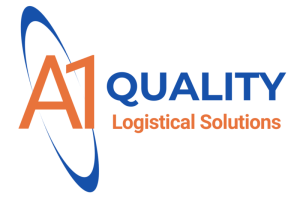A1 Quality Logistical Solutions
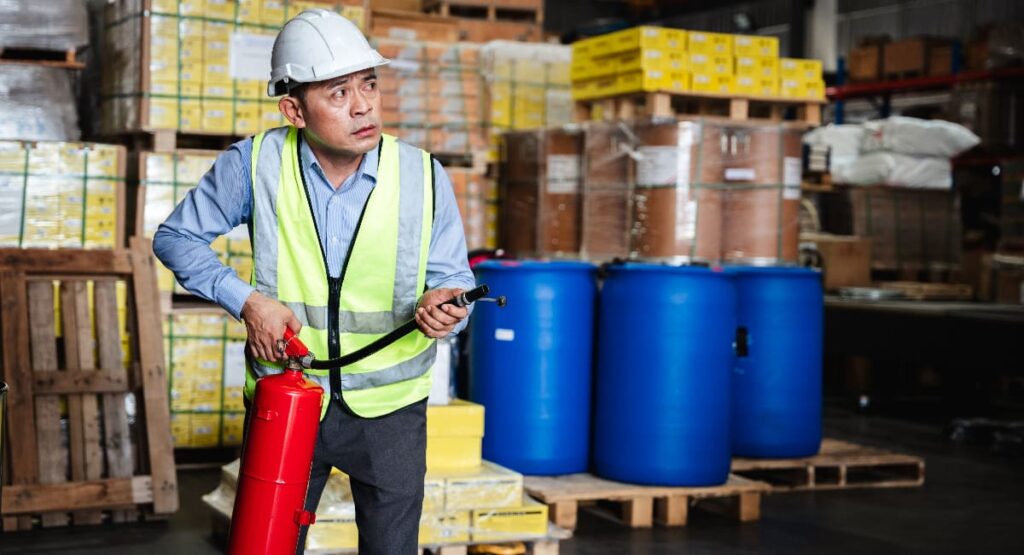
- By Haley
- September 11, 2025
Table of Contents
Key Highlights
- Handling hazardous materials requires strict adherence to safety protocols to protect workers.
- Understanding and complying with OSHA standards is essential for meeting regulatory requirements.
- Proper employee training on hazmat handling and emergency procedures is non-negotiable.
- Following best practices for storage and transport prevents accidents and ensures efficiency.
- Regular audits and using safety checklists help maintain a safe warehouse environment.
- Knowing the right Personal Protective Equipment (PPE) is critical for everyday safety.
Introduction
Welcome to the essential guide on hazmat handling in warehousing! If your warehouse facility deals with hazardous materials, you know that safety and compliance are top priorities. Managing these substances involves more than just finding shelf space; it requires a deep understanding of the risks, strict adherence to regulatory requirements, and a commitment to protecting your team. This guide will walk you through the key aspects of hazmat safety, from regulations and training to best practices you can implement today.
Understanding Hazmat in Warehousing
Working with hazardous materials introduces unique challenges to any warehouse environment. These substances can pose significant risks to warehouse workers if not managed correctly, making specialized knowledge crucial for both safety and operational efficiency.
To run a smooth operation, you must have clear systems in place that align with all regulatory requirements. This involves everything from how materials are stored to the personal protective equipment your team wears. Let’s explore what defines these materials and why handling them properly is so important.

Defining Hazardous Materials and Their Categories
So, what exactly are hazardous materials? In a warehouse facility, these are any substances that can pose a risk to health, safety, or the environment. They can be flammable, toxic, corrosive, or explosive. Think of everything from industrial cleaning chemicals and flammable liquids to combustible materials and compressed gases.
Each category of hazardous material has its own set of handling requirements. For instance, flammable liquids must be kept away from ignition sources, while toxic chemicals need secure storage to prevent exposure. Understanding these distinctions is the first step toward creating a safe handling plan.
This is where Safety Data Sheets (SDS) become invaluable. An SDS provides detailed information about a chemical’s properties and dangers. It’s a vital resource that helps you follow the right safety protocols and comply with important warehouse safety regulations, which are designed to prevent accidents before they happen.
Why Hazmat Handling Is Critical in Warehouses
The importance of correct hazmat handling cannot be overstated. According to the U.S. Bureau of Labor Statistics, the warehousing industry has a fatal injury rate that is higher than the national average for all industries. This highlights the inherent dangers and the need for rigorous safety measures.
Effective hazmat management directly impacts your operational efficiency. Mishaps like spills or chemical exposures can lead to significant downtime, damage to inventory, and delays in order fulfillment. Proper employee training and safety protocols minimize these risks, allowing your team to work confidently and productively.
Ultimately, prioritizing hazmat safety protects your most valuable asset: your people. By adhering to guidelines set by the Occupational Safety and Health Administration (OSHA), you create a secure work environment and demonstrate a commitment to your team’s well-being. Practical tips for improving safety start with understanding and following these established rules.
Key Safety Regulations for Hazmat Handling
When it comes to hazmat, you can’t just guess what to do. A framework of safety regulations exists to guide every step you take. In the United States, the Occupational Safety and Health Administration (OSHA) sets the primary standards for workplace safety, which are crucial for any warehouse handling hazardous materials.
Staying compliant with these OSHA standards isn’t just about avoiding fines; it’s about creating a fundamentally safe workplace. These regulatory requirements provide a clear roadmap for everything from training to emergency planning. Let’s look at what some of these key regulations entail.
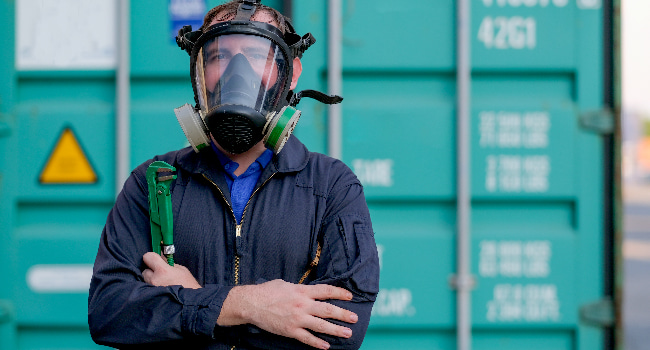
Overview of OSHA Requirements
OSHA provides several key standards that apply directly to warehouse operations to ensure occupational safety. One of the most important is the Hazard Communication Standard (HazCom). This rule requires employers to inform workers about the chemical hazards they might encounter and train them on how to protect themselves.
To help you stay compliant, OSHA outlines specific programs and plans that your warehouse must implement. These are designed to prepare your team for various scenarios and ensure everyone knows their role in maintaining safety.
- Emergency Action Plan (EAP): This plan details the procedures employees must follow during a fire or other emergency.
- Fire Safety Plan: For facilities with more than 10 employees, a written plan must be available that outlines fire prevention measures.
- Hazard Communication (HazCom) Program: You must have a written program that includes Safety Data Sheets (SDS) for all hazardous chemicals.
Proper safety training on these requirements is the most effective way for warehouse workers to remain compliant with OSHA standards. When everyone understands the rules and their importance, you build a stronger culture of safety.
Other Federal and State Safety Standards
Beyond OSHA, other agencies in the United States also establish safety regulations for hazmat handling. The Environmental Protection Agency (EPA), for example, has its own set of rules, particularly concerning hazardous waste management. These regulations dictate how hazardous materials must be stored, treated, and disposed of to protect the environment.
These EPA requirements directly influence the design and operation of your warehouse. For instance, your facility may need specific spill containment systems, proper ventilation, and robust emergency response plans to comply with environmental laws. These rules work in tandem with OSHA standards to create a comprehensive safety net.
It’s also important to remember that individual states may have their own safety standards that can be even stricter than federal ones. Staying informed about both federal and state-level regulatory requirements is essential for ensuring full compliance and maintaining a safe, legally sound operation.
Key Advantages of Cross-Docking
Streamlined logistics operations are among the standout benefits of cross-docking, allowing for faster order fulfillment and bolstered customer satisfaction. By minimizing storage time, businesses can reduce inventory management costs while enhancing supply chain visibility, thus improving overall operational efficiency. Additionally, cross-docking promotes lower shipping costs by optimizing transportation services and reducing handling. This method also supports eCommerce brands by ensuring that new products move quickly through the supply chain, ultimately leading to increased responsiveness to market conditions and a more efficient shipping process.
Common Hazards When Storing and Handling Hazmat
Storing and handling hazardous chemicals comes with a specific set of risks that every warehouse operator must be aware of. From spills and leaks to fires and explosions, the potential for serious incidents is always present if the right precautions aren’t taken.
Understanding these common hazards is the first step toward preventing them. With established safety protocols and readily available Safety Data Sheets (SDS), you can equip your team to identify and mitigate these dangers effectively. Let’s break down some of the most significant risks.
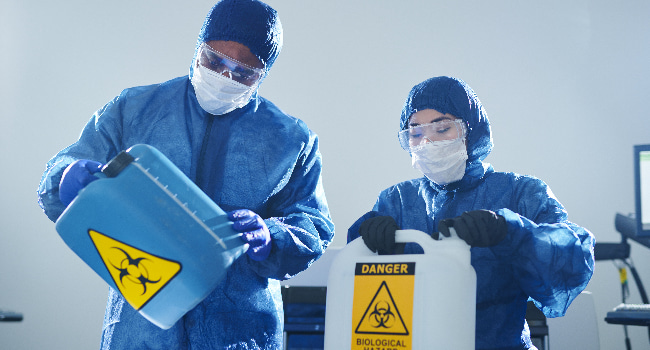
Chemical Exposure Risks and Spill Dangers
One of the most immediate dangers when handling hazardous materials is chemical exposure. This can happen through inhalation, skin contact, or ingestion and may cause anything from minor irritation to severe chemical burns or long-term health problems. Proper handling procedures and the use of PPE are your first lines of defense.
Spills pose another significant threat. A spill can create a slip hazard, release toxic fumes, or cause environmental damage. Having clear emergency procedures is critical to managing a spill quickly and safely. The immediate steps taken can make all the difference in minimizing the impact.
- Have a written spill control plan and ensure all employees are trained on it.
- Keep spill cleanup kits readily accessible in areas where hazardous materials are stored or used.
- Train employees on how to properly clean up spills and dispose of the used materials according to safety protocols.
Following these steps ensures that if a spill occurs, your team can respond immediately and effectively, protecting themselves and the facility.
Fire, Explosion, and Environmental Hazards
Fire and explosion are among the most catastrophic hazards associated with hazardous chemicals. Many substances, such as flammable and combustible liquids, can ignite if not stored correctly. Even areas like battery charging stations can pose a fire risk if proper precautions aren’t taken.
To prevent these incidents, a multi-layered approach to fire protection is needed. This involves both facility design and daily practices to mitigate risks.
- Store flammable materials in well-ventilated areas away from ignition sources.
- Ensure fire extinguishers are available, inspected, and accessible. Prohibit smoking and open flames near storage areas.
- Use containers designed to prevent static electricity buildup for combustible materials.
Beyond immediate safety, environmental hazards are also a major concern. Leaks or improper disposal of hazardous chemicals can contaminate soil and water, leading to long-term damage and legal consequences. Proper containment and disposal procedures are essential to prevent this.
Essential PPE and Safety Equipment for Hazmat Operations
Having the right gear is fundamental to hazmat safety. Personal Protective Equipment (PPE) acts as a crucial barrier between warehouse workers and potential hazards. The Occupational Safety and Health Administration (OSHA) mandates that employers provide appropriate PPE for the tasks at hand.
These safety measures are not optional—they are an integral part of a comprehensive safety program. Equipping your team with the correct PPE and other specialized tools ensures they can perform their duties without risking their health. Let’s explore the specific equipment your team needs.

Required Personal Protective Equipment (PPE)
For true occupational safety, your team must be outfitted with the correct PPE for their specific tasks. Safety regulations require employers to provide this equipment and ensure employees are trained on how to use it correctly.
Different hazards call for different types of protection. A thorough risk assessment will help you determine what is needed, but some items are standard in most warehouse environments handling hazardous materials.
- Eye and Face Protection: Safety glasses or face shields are crucial when working with chemicals that could splash or create airborne particles.
- Hand Protection: The right gloves protect against chemical burns, cuts, and electrical hazards. Insulated gloves are necessary for certain electrical risks.
- Foot and Head Protection: Slip- and puncture-resistant boots protect feet from falling objects and spills, while hard hats guard against falling items.
Proper employee training ensures everyone understands which PPE to use and when. This knowledge empowers workers to take an active role in their own safety and helps maintain compliance with all safety regulations.
Specialized Safety Tools and Emergency Gear
Beyond the PPE worn by individuals, a well-equipped warehouse facility needs specialized safety equipment to handle emergencies. These tools are critical for a swift and effective response when an incident occurs, helping to contain the situation and protect your team.
Having this equipment on hand is a practical tip for improving safety, as it allows for an immediate response. Your emergency procedures should clearly outline where these tools are located and how to use them.
- Portable Fire Extinguishers: These must be placed in accessible locations throughout the warehouse, fully charged, and inspected monthly. Your team should be trained on how to use them for different classes of fire.
- Spill Cleanup Kits: These kits contain absorbent materials and tools needed to safely manage chemical spills. They should be stored near any area where chemicals are handled.
- Emergency Shut-offs: Emergency buttons or pull cords for equipment like conveyors can prevent serious injuries by stopping machinery instantly.
Investing in and maintaining this safety equipment is just as important as providing PPE. It ensures your entire warehouse facility is prepared to manage hazards effectively.
Warehouse Best Practices for Hazmat Storage and Handling
Following established best practices is the key to safe and efficient hazmat management. These guidelines go beyond basic compliance to create a system that prioritizes safe storage and handling in every aspect of your operations, from receiving to order fulfillment.
Implementing these practices helps prevent accidents, protect your inventory, and keep your team safe. A modern warehouse management system can even help enforce these rules by tracking materials and guiding placement. Let’s review some of the most effective techniques.

Safe Storage Techniques and Labeling
Proper storage is the foundation of warehouse safety. The way you organize your warehouse space can either prevent or create hazards. Following proven safe storage techniques is crucial for effective inventory management and accident prevention.
Clear safety protocols for storage help everyone on your team handle materials correctly. Here are a few essential rules to implement:
- Stack loads evenly and straight, with heavier loads placed on lower or middle shelves to maintain stability.
- Keep aisles and passageways clear of any materials to prevent slip, trip, and fall hazards.
- Clearly mark the maximum safe load limits for shelving and floors and ensure they are never exceeded.
Accurate and visible labeling is just as important. Every container of hazardous material must be clearly labeled with its contents and associated dangers. This ensures that anyone handling the material knows exactly what it is and what precautions to take, which is fundamental to the safest possible storage.
Procedures for Proper Handling and Transport
Once materials are stored safely, it’s equally important to have procedures for handling and moving them around the warehouse. Every time a hazardous substance is transported, there is a risk of an incident. Clear safety measures protect warehouse workers and inventory during these movements.
Training is essential here. Your team must understand the right way to lift, carry, and operate machinery to prevent injuries and spills. These procedures help maintain consistent safety and don’t have to slow down delivery times.
- Train all workers in proper ergonomic lifting techniques to prevent back and knee injuries.
- Ensure all forklift operators are certified and perform daily equipment inspections before use.
- Establish designated paths for forklifts and other vehicles, keeping them separate from pedestrian walkways where possible.
By standardizing these handling and transport procedures, you create a predictable and safe environment where your team can work efficiently without compromising on safety.
Building an Effective Hazmat Safety Training Program
A well-trained team is your best defense against hazmat incidents. An effective safety training program is more than a one-time orientation; it’s an ongoing process that equips every employee in your warehouse facility with the knowledge and skills to work safely.
Building this program involves identifying key topics, using practical teaching methods, and committing to regular refreshers. So, what are the essential steps to create a training program that truly sticks and keeps your team prepared for any situation?

Core Topics to Cover in Training Sessions
Creating an effective safety training program starts with a solid curriculum. Your employee training must cover all the critical safety protocols and regulatory requirements specific to your facility. This ensures every worker has the same baseline knowledge.
A comprehensive program should be tailored to your specific operations, but several core topics are universally essential for hazmat handling. Make sure your training sessions include:
- Hazard Communication: How to read labels and Safety Data Sheets (SDS) to understand chemical risks.
- Proper PPE Use: Which equipment to use for different tasks and how to wear, maintain, and store it correctly.
- Emergency Procedures: What to do in case of a spill, fire, or chemical exposure, including evacuation routes and who to contact.
- Safe Handling and Storage: Best practices for lifting, moving, and storing different types of hazardous materials.
Covering these topics thoroughly provides your team with the foundational knowledge needed to follow safety protocols and respond correctly in an emergency.
Practical Drills, Simulations, and Ongoing Refreshers
Classroom learning is important, but practical experience is what makes safety training effective. Hands-on drills and simulations allow employees to practice emergency procedures in a controlled environment, building muscle memory and confidence. This is where safety protocols move from theory to action.
Incorporating these practical elements reinforces learning and can even improve operational efficiency by making correct procedures second nature. Consider adding these to your employee training schedule:
- Spill Response Drills: Simulate a chemical spill and have teams practice using the spill kit and following containment procedures.
- Fire Drills: Conduct regular fire drills so everyone knows the evacuation routes and assembly points.
- Forklift Operation Refreshers: Regular practice helps operators maintain their skills and reinforces safe driving habits.
Safety training should never be a one-and-done event. Ongoing refreshers are crucial, especially when new hazards are introduced or safety protocols are updated. Annual training is a common standard, but more frequent sessions may be needed for high-risk tasks.
Proactive Risk Assessment and Incident Prevention
The best way to handle an incident is to prevent it from ever happening. A proactive approach to safety, centered on risk assessment and incident prevention, is far more effective than a reactive one. This means actively looking for potential hazards within your warehouse facility.
By implementing forward-thinking safety measures, you can identify and address risks before they lead to accidents. This approach empowers management to create a safer environment for everyone. Let’s look at how regular audits and early hazard identification play a key role.

Conducting Regular Hazmat Safety Audits
Regular safety audits are a cornerstone of proactive risk assessment. These systematic reviews of your warehouse help you verify that safety protocols are being followed and identify any gaps in your procedures. Audits are also essential for documenting compliance with regulatory requirements.
A good audit is thorough and methodical. It should cover everything from equipment maintenance to employee practices. Using a checklist can ensure you don’t miss anything. Your warehouse management system might even have features to help you schedule and track these audits.
Here is an example of what a simple audit checklist might include:
Audit Area | Item to Check | Status (Pass/Fail) |
Storage | Are aisles and exits clear? |
|
PPE | Is appropriate PPE available and in good condition? |
|
Equipment | Are fire extinguishers charged and accessible? |
|
Documentation | Are Safety Data Sheets available for all chemicals? |
|
Handling | Are workers following proper lifting procedures? |
|
Conducting these safety audits regularly helps management identify and address workplace safety risks before they escalate into incidents.
Identifying and Addressing Potential Hazards Early
Beyond formal audits, incident prevention is an everyday activity. Encouraging your entire team to be vigilant and report potential hazards is one of the most effective safety measures you can take. A strong safety culture is one where everyone feels responsible for identifying risks.
This continuous risk assessment helps you spot common hazards before they cause a problem. Often, these are simple things that can be fixed quickly but could lead to serious injury if ignored.
- Improperly stacked materials: Loads that are uneven or too high can fall and injure someone. Correct them immediately.
- Blocked emergency exits or equipment: Ensure fire extinguishers, eyewash stations, and exits are always clear.
- Damaged equipment: A frayed electrical cord or a leaky container should be reported and removed from service right away.
By addressing these issues as soon as they are found, you create a much safer work environment and prevent many common warehouse accidents.
Warehouse Hazmat Safety Checklists & Compliance Monitoring
To make safety a consistent habit, tools like checklists are incredibly useful. A safety checklist provides a simple, repeatable way to monitor your warehouse space and ensure you are meeting all regulatory requirements on a daily basis.
This approach to compliance monitoring makes it easy for supervisors and employees to perform quick checks and document their findings. It turns abstract rules into tangible action items. So, what should you actually put on these checklists to make them effective?
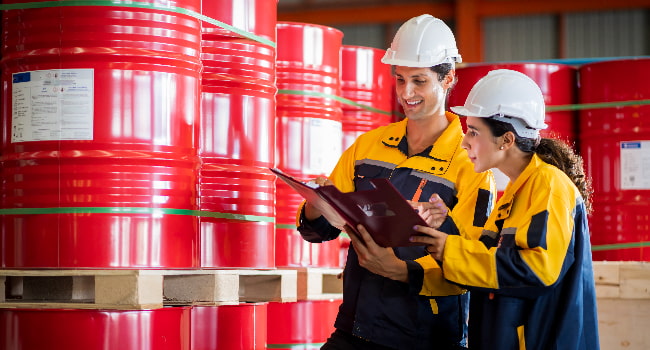
Daily Safety Checklist Essentials
A daily safety checklist helps integrate safety protocols into your team’s regular routine, improving both safety and operational efficiency. This list should be straightforward and focus on the most critical, high-frequency checks that can prevent common accidents.
The goal isn’t to conduct a full audit every day, but to catch obvious hazards quickly. A good daily checklist empowers your team to take ownership of their work areas.
- Work Area Tidiness: Are floors clear of debris, spills, or anything that could cause a slip or trip?
- PPE Availability: Is the necessary PPE available at workstations and in good condition?
- Emergency Access: Are fire extinguishers, emergency exits, and first-aid stations unobstructed?
- Proper Storage: Are materials stacked securely and within their designated areas?
By running through these essentials at the start of each shift, you can ensure the environment is safe before the workday even begins.
Keeping Records for Regulatory Compliance
Careful record-keeping is a critical part of compliance monitoring. When an OSHA inspector visits, having organized documentation of your safety efforts demonstrates your commitment to meeting regulatory requirements. These records prove that you are not just talking about safety, but actively managing it.
Your documentation should include completed safety checklists, records of employee training sessions, equipment inspection logs, and details of any incidents that have occurred. A robust warehouse management system can be a great tool for storing and organizing this information digitally, making it easy to access.
This habit of documentation helps warehouse workers stay compliant because it creates a clear paper trail of all safety activities. It holds everyone accountable and provides valuable data that you can use to identify trends and continuously improve your safety programs. Good records are your best evidence of a strong safety culture.
Special Considerations for Chemical Storage in Warehouses
While all hazmat requires care, chemical storage presents some unique challenges. Chemicals can have very specific needs regarding temperature, ventilation, and segregation to prevent dangerous reactions or degradation. This goes beyond general safe storage practices.
To avoid risks like cross-contamination or fires, you need to pay close attention to these special considerations. Proper fire protection and environmental controls are not just best practices—they are essential for safety when dealing with volatile substances. Let’s dig into these specific requirements.
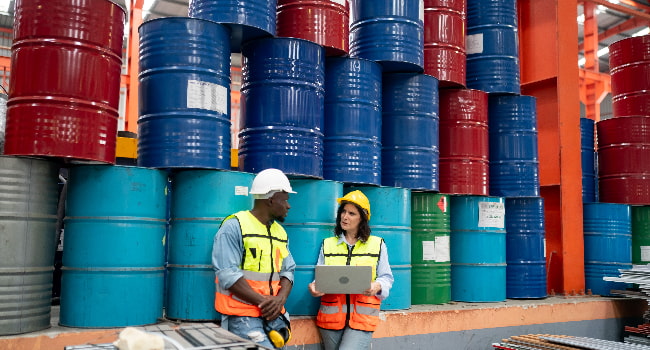
Segregation, Ventilation, and Temperature Control
One of the most important rules of chemical storage is segregation. Incompatible chemicals, such as acids and bases or oxidizers and flammables, must be stored separately to prevent dangerous reactions if they were to leak and mix. Your warehouse space should be designed with this principle in mind.
Proper ventilation is another critical factor, especially for flammable or toxic substances. Good airflow helps dissipate fumes that could be harmful to inhale or create a fire hazard. For certain chemicals, temperature control is also non-negotiable.
- Store flammable liquids in a well-ventilated area away from any potential ignition sources.
- Designate separate storage areas for incompatible chemical classes.
- Use temperature-controlled or cold storage for chemicals that are sensitive to heat or moisture.
These special considerations are fundamental to fire protection and overall safety in any facility that handles a diverse range of chemicals.
Preventing Cross-Contamination and Leaks
Preventing cross-contamination and leaks is essential for both safety and product integrity. Even small leaks can lead to dangerous chemical reactions, create hazardous fumes, or damage other inventory. This is a common hazard that requires proactive prevention.
The key to prevention lies in using the right containers and having secondary containment measures in place. This ensures that if a primary container fails, the spill is contained before it can spread.
- Use containers that are appropriate for the chemical being stored and ensure they are sealed properly.
- Store liquid chemicals on shelves with spill trays or in designated containment areas.
- Regularly inspect containers and storage areas for any signs of leaks, corrosion, or damage.
By focusing on these safe storage practices, you can dramatically reduce the risk of cross-contamination and leaks, keeping your chemical storage areas clean and secure.
Conclusion
In summary, effective hazmat handling in warehousing is essential for ensuring safety, compliance, and operational efficiency. By understanding the importance of hazardous materials, adhering to safety regulations, and implementing best practices, warehouses can significantly mitigate risks associated with chemical exposure and incidents. A well-structured safety training program, proactive risk assessments, and thorough compliance monitoring further enhance safety measures, protecting both personnel and the environment. Remember, staying informed and prepared is key to a safe working environment. If you would like to learn more about creating a robust hazmat handling strategy, don’t hesitate to reach out for assistance!
Frequently Asked Questions
What is the safest way to store hazardous materials in a warehouse?
The safest way to store hazardous materials is to follow the guidance on their Safety Data Sheets (SDS). This includes segregating incompatible chemicals, using proper labeling, and ensuring your warehouse facility has correct ventilation and spill containment. Adhering to all local and federal regulatory requirements for safe storage is also essential.
How often should hazmat safety training be updated?
Hazmat safety training should be conducted for all new employees and refreshed for all staff at least annually. More frequent employee training may be necessary if new hazards are introduced into the warehouse facility, procedures change, or when required by specific OSHA standards or other regulatory requirements.
What immediate steps should be taken if a hazmat spill occurs?
If a hazmat spill occurs, immediately alert all nearby warehouse workers and evacuate the area if necessary. Follow your facility’s emergency procedures, which should include consulting the material’s SDS, using the appropriate spill kit and PPE, and notifying a supervisor. Do not attempt to clean it up without proper training.

Haley serves as the Marketing Manager for A1 Quality Logistical Solutions. She joined A1QLS in 2023 with her prior experience gained with GXO and XPO Logistics.
